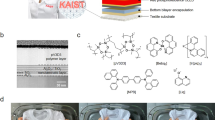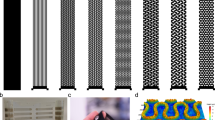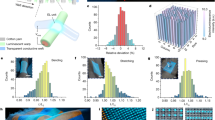Abstract
Textiles represent a fundamental material format that is extensively integrated into our everyday lives. The quest for more versatile and body-compatible wearable electronics has led to the rise of electronic textiles (e-textiles). By enhancing textiles with electronic functionalities, e-textiles define a new frontier of wearable platforms for human augmentation. To realize the transformational impact of wearable e-textiles, materials innovations can pave the way for effective user adoption and the creation of a sustainable circular economy. We propose a repair, recycle, replacement and reduction circular e-textile paradigm. We envisage a systematic design framework embodying material selection and biofabrication concepts that can unify environmental friendliness, market viability, supply-chain resilience and user experience quality. This framework establishes a set of actionable principles for the industrialization and commercialization of future sustainable e-textile products.
This is a preview of subscription content, access via your institution
Access options
Access Nature and 54 other Nature Portfolio journals
Get Nature+, our best-value online-access subscription
$29.99 / 30 days
cancel any time
Subscribe to this journal
Receive 12 print issues and online access
$259.00 per year
only $21.58 per issue
Buy this article
- Purchase on Springer Link
- Instant access to full article PDF
Prices may be subject to local taxes which are calculated during checkout




Similar content being viewed by others
References
Barber, E. J. W. Prehistoric Textiles: The Development of Cloth in the Neolithic and Bronze Ages with Special Reference to the Aegean (Princeton Univ. Press, 1991).
Ding, T. et al. Scalable thermoelectric fibers for multifunctional textile-electronics. Nat. Commun. 11, 6006 (2020).
Liao, M. et al. Industrial scale production of fibre batteries by a solution-extrusion method. Nat. Nanotechnol. 17, 372–377 (2022).
Fan, W. et al. Machine-knitted washable sensor array textile for precise epidermal physiological signal monitoring. Sci. Adv. 6, eaay2840 (2020).
Yan, W. et al. Single fibre enables acoustic fabrics via nanometre-scale vibrations. Nature 603, 616–623 (2022).
Shi, X. et al. Large-area display textiles integrated with functional systems. Nature 591, 240–245 (2021).
Maziz, A. et al. Knitting and weaving artificial muscles. Sci. Adv. 3, e1600327 (2017).
Rajappan, A. et al. Logic-enabled textiles. Proc. Natl Acad. Sci. USA 119, e2202118119 (2022).
Xiao, X. et al. An ultrathin rechargeable solid-state zinc ion fiber battery for electronic textiles. Sci. Adv. 7, eabl3742 (2021).
Chen, G. et al. Electronic textiles for wearable point-of-care systems. Chem. Rev. 122, 3259–3291 (2021).
Zhu, B. et al. Subambient daytime radiative cooling textile based on nanoprocessed silk. Nat. Nanotechnol. 16, 1342–1348 (2021).
Park, H. L. et al. Flexible neuromorphic electronics for computing, soft robotics, and neuroprosthetics. Adv. Mater. 32, 1903558 (2020).
Libanori, A., Chen, G., Zhao, X., Zhou, Y. & Chen, J. Smart textiles for personalized healthcare. Nat. Electron. 5, 142–156 (2022).
Hexoskin https://www.hexoskin.com/ (accessed 15 January 2023).
Myant https://www.myant.ca/ (accessed 15 January 2023).
Nanowear Inc. https://www.nanowearinc.com/ (accessed 15 January 2023).
Clim8 https://www.myclim8.com/ (accessed 15 January 2023).
Fieldsheer https://www.fieldsheer.com (accessed 15 January 2023).
Ororo Wear https://www.ororowear.com/ (accessed 15 January 2023).
Advanced Functional Fabrics of America https://www.affoa.org/ (accessed 15 January 2023).
Adetexs Advanced Textiles https://www.adetexs.com/ (accessed 15 January 2023).
Hype Cycle for Consumer Devices (Gartner, 2015).
Jansen, K. M. How to shape the future of smart clothing. In Adjunct Proc. 2019 ACM International Joint Conference on Pervasive and Ubiquitous Computing and Proc. 2019 ACM International Symposium on Wearable Computers 1037–1039 (ACM, 2019).
Hayward, J. E-textiles and Smart Clothing 2020-2030: Technologies, Markets and Players (IDTechEx, 2020); https://www.idtechex.com/en/research-report/e-textiles-and-smart-clothing-2020-2030-technologies-markets-and-players/735
Forti, V., Balde, C. P., Kuehr, R. & Bel, G. The Global E-waste Monitor 2020: Quantities, Flows and the Circular Economy Potential (UNU/UNITAR, ITU and ISWA 2020); https://ewastemonitor.info/wp-content/uploads/2020/11/GEM_2020_def_july1_low.pdf
Paraschiv, D., Tudor, C. & Petrariu, R. The textile industry and sustainable development: a Holt–Winters forecasting investigation for the Eastern European area. Sustainability 7, 1280–1291 (2015).
Boucher, J. & Friot, D. Primary Microplastics in the Oceans: A Global Evaluation of Sources (IUCN, 2017).
Ball, P. Materials innovation from quantum to global. Nat. Mater. 21, 962–967 (2022).
Loke, G., Yan, W., Khudiyev, T., Noel, G. & Fink, Y. Recent progress and perspectives of thermally drawn multimaterial fiber electronics. Adv. Mater. 32, 1904911 (2020).
Hwang, S. et al. Integration of multiple electronic components on a microfibre towards an emerging electronic textile platform. Nat. Commun. 13, 3173 (2022).
Sanjay, M. et al. Characterization and properties of natural fiber polymer composites: a comprehensive review. J. Clean. Prod. 172, 566–581 (2018).
Ma, Y., Feng, X., Rogers, J. A., Huang, Y. & Zhang, Y. Design and application of ‘J-shaped’ stress–strain behavior in stretchable electronics: a review. Lab Chip 17, 1689–1704 (2017).
Gong, S., Zhang, B., Zhang, J., Wang, Z. L. & Ren, K. Biocompatible poly (lactic acid)‐based hybrid piezoelectric and electret nanogenerator for electronic skin applications. Adv. Funct. Mater. 30, 1908724 (2020).
Boutry, C. M. et al. Biodegradable and flexible arterial-pulse sensor for the wireless monitoring of blood flow. Nat. Biomed. Eng. 3, 47–57 (2019).
Ates, H. C. et al. End-to-end design of wearable sensors. Nat. Rev. Mater. 7, 887–907 (2022).
Sadanandan, K. S. et al. Graphene coated fabrics by ultrasonic spray coating for wearable electronics and smart textiles. J. Phys. Mater. 4, 014004 (2020).
Bashid, H. A. A. et al. Electrodeposition of polypyrrole and reduced graphene oxide onto carbon bundle fibre as electrode for supercapacitor. Nanosc. Res. Lett. 12, 246 (2017).
Brookstein, D. S. Factors associated with textile pattern dermatitis caused by contact allergy to dyes, finishes, foams, and preservatives. Dermatol. Clin. 27, 309–322 (2009).
Baroli, B. Penetration of nanoparticles and nanomaterials in the skin: fiction or reality? J. Pharm. Sci. 99, 21–50 (2010).
Monteiro-Riviere, N. A. & Inman, A. O. Challenges for assessing carbon nanomaterial toxicity to the skin. Carbon 44, 1070–1078 (2006).
Chen, G., Li, Y., Bick, M. & Chen, J. Smart textiles for electricity generation. Chem. Rev. 120, 3668–3720 (2020).
Xu, Z. & Gao, C. Graphene fiber: a new trend in carbon fibers. Mater. Today 18, 480–492 (2015).
Napper, I. E. & Thompson, R. C. Release of synthetic microplastic plastic fibres from domestic washing machines: effects of fabric type and washing conditions. Mar. Pollut. Bull. 112, 39–45 (2016).
Lahiri, S. K., Azimi Dijvejin, Z. & Golovin, K. Polydimethylsiloxane-coated textiles with minimized microplastic pollution. Nat. Sustain. 6, 559–567 (2023).
Ju, B. et al. Inkjet printed textile force sensitive resistors for wearable and healthcare devices. Adv. Healthc. Mater. 10, 2100893 (2021).
Loke, G. et al. Digital electronics in fibres enable fabric-based machine-learning inference. Nat. Commun. 12, 3317 (2021).
Feilden, E. et al. 3D printing bioinspired ceramic composites. Sci. Rep. 7, 13759 (2017).
Wang, W. et al. Inflight fiber printing toward array and 3D optoelectronic and sensing architectures. Sci. Adv. 6, eaba0931 (2020).
Singh, A., Panghal, D. & Jana, P. Automatic seam ripping system. Proc. Manuf. 30, 98–105 (2019).
Kirschner, M. Why the circular economy will drive green and sustainable chemistry in electronics. Adv. Sustain. Syst. 6, 2100046 (2021).
A New Circular Vision for Electronics: Time for a Global Reboot (World Economic Forum, 2019).
Yin, L. et al. A self-sustainable wearable multi-modular E-textile bioenergy microgrid system. Nat. Commun. 12, 1542 (2021).
Köhler, A. R. Challenges for eco-design of emerging technologies: the case of electronic textiles. Mater. Des. 51, 51–60 (2013).
Maity, S. & Chatterjee, A. Conductive polymer-based electro-conductive textile composites for electromagnetic interference shielding: a review. J. Ind. Text. 47, 2228–2252 (2018).
Kizildag, N. & Ucar, N. Nanocomposite polyacrylonitrile filaments with electrostatic dissipative and antibacterial properties. J. Composite Mater. 50, 4279–4289 (2016).
Ford, S. & Minshall, T. Invited review article: where and how 3D printing is used in teaching and education. Addit. Manuf. 25, 131–150 (2019).
Alshabouna, F. et al. PEDOT: PSS-modified cotton conductive thread for mass manufacturing of textile-based electrical wearable sensors by computerized embroidery. Mater. Today 59, 56–67 (2022).
Chandler, A. D. Jr, Hikino, T. & Von Nordenflycht, A. Inventing the Electronic Century: The Epic Story of the Consumer Electronics and Cmputer Industries Vol. 47 (Harvard Univ. Press, 2005).
Liu, S. et al. A neuroanatomical basis for electroacupuncture to drive the vagal–adrenal axis. Nature 598, 641–645 (2021).
Vatankhah-Varnosfaderani, M. et al. Chameleon-like elastomers with molecularly encoded strain-adaptive stiffening and coloration. Science 359, 1509–1513 (2018).
Yuk, H., Zhang, T., Parada, G. A., Liu, X. & Zhao, X. Skin-inspired hydrogel–elastomer hybrids with robust interfaces and functional microstructures. Nat. Commun. 7, 12028 (2016).
Liu, X., Liu, J., Lin, S. & Zhao, X. Hydrogel machines. Mater. Today 36, 102–124 (2020).
Song, E. et al. Miniaturized electromechanical devices for the characterization of the biomechanics of deep tissue. Nat. Biomed. Eng. 5, 759–771 (2021).
Yu, B. et al. An elastic second skin. Nat. Mater. 15, 911–918 (2016).
Yan, D. et al. Soft three-dimensional network materials with rational bio-mimetic designs. Nat. Commun. 11, 1180 (2020).
Lee, S. et al. Nanomesh pressure sensor for monitoring finger manipulation without sensory interference. Science 370, 966–970 (2020).
Park, M. et al. Highly stretchable electric circuits from a composite material of silver nanoparticles and elastomeric fibres. Nat. Nanotechnol. 7, 803–809 (2012).
Buckner, T. L., Bilodeau, R. A., Kim, S. Y. & Kramer-Bottiglio, R. Roboticizing fabric by integrating functional fibers. Proc. Natl Acad. Sci. USA 117, 25360–25369 (2020).
Kanik, M. et al. Strain-programmable fiber-based artificial muscle. Science 365, 145–150 (2019).
Zhang, D. et al. Abrasion resistant/waterproof stretchable triboelectric yarns based on fermat spirals. Adv. Mater. 33, 2100782 (2021).
Zhu, R. et al. Biomimetic fabrication of janus fabric with asymmetric wettability for water purification and hydrophobic/hydrophilic patterned surfaces for fog harvesting. ACS Appl. Mater. Interf. 12, 50113–50125 (2020).
Saetia, K. et al. Spray-layer-by-layer carbon nanotube/electrospun fiber electrodes for flexible chemiresistive sensor applications. Adv. Funct. Mater. 24, 492–502 (2014).
Shuai, L. et al. Stretchable, self-healing, conductive hydrogel fibers for strain sensing and triboelectric energy-harvesting smart textiles. Nano Energy 78, 105389 (2020).
Qian, J. et al. Highly stable, antiviral, antibacterial cotton textiles via molecular engineering. Nat. Nanotechnol. 18, 168–176 (2023).
Kulpinski, P., Namyslak, M., Grzyb, T. & Lis, S. Luminescent cellulose fibers activated by Eu3+-doped nanoparticles. Cellulose 19, 1271–1278 (2012).
Orelma, H. et al. Optical cellulose fiber made from regenerated cellulose and cellulose acetate for water sensor applications. Cellulose 27, 1543–1553 (2020).
Yang, C. et al. Copper-coordinated cellulose ion conductors for solid-state batteries. Nature 598, 590–596 (2021).
Yang, D. L., Faraz, F., Wang, J. X. & Radacsi, N. Combination of 3D printing and electrospinning techniques for biofabrication. Adv. Mater. Technol. 7, 2101309 (2022).
Gantenbein, S. et al. Three-dimensional printing of mycelium hydrogels into living complex materials. Nat. Mater. 22, 128–134 (2022).
Supply–Demand Mismatch Looms Large For Smart Clothing (Technical Textile, 2023); https://www.technicaltextile.net/articles/supply-demand-mismatch-looms-large-for-smart-clothing-9134
Ju, N. & Lee, K.-H. Consumer resistance to innovation: smart clothing. Fash. Text. 7, 21 (2020).
E-Textiles Market: Global Opportunity Analysis and Industry Forecast 2021-2031 (Allied Market Research, 2023); https://www.alliedmarketresearch.com/e-textile-market-A16100
Survey: Consumer Sentiment on Sustainability in Fashion (McKinsey & Company, 2023); https://www.mckinsey.com/industries/retail/our-insights/survey-consumer-sentiment-on-sustainability-in-fashion
Acknowledgements
We thank J. Jur (from Advanced Functional Fabrics of America (AFFOA)), N. Khalili (from Inkbox) and other anonymous industrial experts and interviewees who provided their valuable opinions and insights for this Perspective.
Author information
Authors and Affiliations
Corresponding author
Ethics declarations
Competing interests
The authors declare no competing interests.
Peer review
Peer review information
Nature Materials thanks Jun Chen, Sung Kyu Park and the other, anonymous, reviewer(s) for their contribution to the peer review of this work.
Additional information
Publisher’s note Springer Nature remains neutral with regard to jurisdictional claims in published maps and institutional affiliations.
Rights and permissions
Springer Nature or its licensor (e.g. a society or other partner) holds exclusive rights to this article under a publishing agreement with the author(s) or other rightsholder(s); author self-archiving of the accepted manuscript version of this article is solely governed by the terms of such publishing agreement and applicable law.
About this article
Cite this article
Shi, H.H., Pan, Y., Xu, L. et al. Sustainable electronic textiles towards scalable commercialization. Nat. Mater. 22, 1294–1303 (2023). https://doi.org/10.1038/s41563-023-01615-z
Received:
Accepted:
Published:
Issue Date:
DOI: https://doi.org/10.1038/s41563-023-01615-z
This article is cited by
-
Recent advances in two-dimensional nanomaterials for sustainable wearable electronic devices
Journal of Nanobiotechnology (2024)
-
Motion artefact management for soft bioelectronics
Nature Reviews Bioengineering (2024)
-
Can e-textiles make their way into mass production?
Nature Reviews Electrical Engineering (2024)
-
Research Progress and Development Trend of Textile Auxiliaries
Fibers and Polymers (2024)
-
Multifunctional Cu/poplar-PLA conductive nonwoven fabric for electromyography (EMG) sensing, pressure sensing, and thermal heating applications
Journal of Materials Science (2024)



